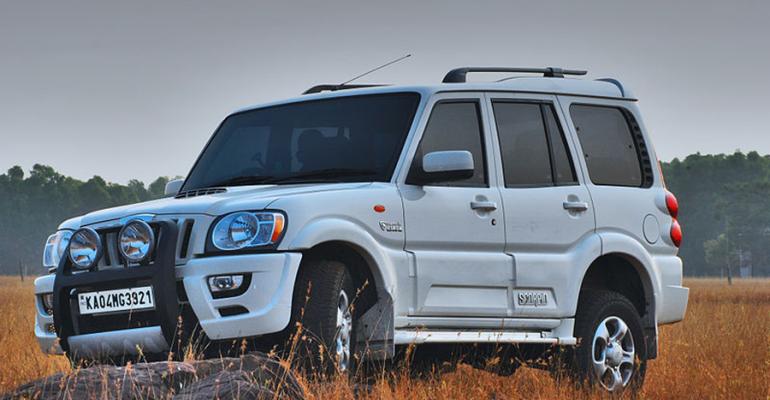MUMBAI – Indian auto maker Mahindra & Mahindra is firing on all cylinders, reporting a 44% jump in net profits for the fiscal fourth quarter ended in March.
Sales in the quarter rose 23.8%, compared with year-ago, to 108,198 units, according to WardsAuto data. With its portfolio of SUVs and light trucks, Mahindra’s growth continued in May, when deliveries jumped 28% to 43,998.
Despite rising costs, the auto maker’s net worth doubled between 2008 and 2011.
Almost all Mahindra vehicles use state-of-the-art diesel engines made in-house. Not only has the wide gap between the cost of diesel fuel and gasoline helped the auto maker stay ahead of the competition, but the fuel economy of Mahindra diesels also is 15%-20% better than that of other auto makers’ gasoline or diesel models.
“Mahindra’s excellent performance is due to the right strategy, and not just the differences in price or fuel economy,” says Vivek Nayer, senior vice president.
That strategy is threefold: vehicle research and innovation, reaching out to customers and offering a variety of models.
Mahindra’s acquisitions of India’s Reva Electric Vehicles in 2010 and ailing South Korean light-truck maker Ssangyong last year, combined with its own research and development facilities, have helped the Indian auto maker field a choice of eight models with 30 variants as well as explore a variety of platforms, engines, vehicle designs and concepts.
Inaugurating its Mahindra Research Valley R&D center last month, Anand Mahindra, vice chairman and managing director, said, “It will put us in the global league” of auto makers.
Anand Mahindra soon will take over as chairman and managing director, succeeding Keshub Mahindra, who recently announced his retirement from the chairmanship after 48 years but will remain as chairman emeritus of the board of directors. The transition will take place after the annual general meeting in August.
The 34 laboratories in Mahindra Research Valley are being used for projects ranging from new engine platforms for both entry-level and high-end vehicles to next-generation hybrids. R&D personnel are developing a family of six new engines for Mahindra.
In the year before the facility launched in 2011, the auto maker spent Rs7 billion ($125.4 million) on research. In recent years, it has been spending 3% of revenue on R&D annually.
Mahindra has steered the formerly loss-making Ssangyong into profitability. The South Korean subsidiary now contributes to Mahindra engine and vehicle innovations. And with Reva surviving and prospering, the parent company is exploring the introduction of electric-vehicle technology across its model range.
Mahindra plans to invest Rs50 billion ($896 million) to double its manufacturing capacity to 500,000 vehicles a year by 2015. The auto maker also has earmarked Rs67 billion ($1.2 billion) for assembly of Ssangyong vehicles in India. The new R&D facility is developing four different engine platforms for the Ssangyong launch here.
Mahindra also plans to build Ssangyong vehicles in Russia from semi-knocked-down kits at three assembly plants operated by Solaris, Ssangyong’s Russian distributor. Mahindra President Pawan Goenka is excited about penetrating such a large market with a minimal investment. Assembly facilities in Brazil and Chile also are on Goenka’s radar.
Mahindra’s acquisitions and new markets depend on “what we can do that others have not done so far,” he says.
The auto maker’s Scorpio SUV remains in great demand after 10 years on the market.
The next-generation model now under development will have a 2.2L, 140-hp mHawk engine with stop/start technology, a longer wheelbase and a new platform providing more legroom in the middle row.
Mahindra’s XUV500 all-wheel-drive luxury SUV is even more technologically advanced, achieving fuel economy of 24/34 mpg (9.8-6.9L/100 km) city/highway with drivetrain components configured to create a flat floor.
The auto maker is working on a smaller XUV500 that is less than 13.1 ft. (4 m) long and, priced at Rs400,000 ($7,170), is in a lower tax bracket.
Other upcoming products are targeted at diversified markets and for export.
Mahindra is developing a compact multipurpose vehicle on the same platform as its Maxximo commercial truck and van to compete against the Toyota Innova and Tata Aria, just-launched Maruti Suzuki Ertiga and upcoming Ford EcoSport, GM Enjoy and Ashok Leyland-Nissan Evalia.
Mahindra not only is modernizing its existing diesel-engine range but also is developing a next-generation Reva EV. The new R&D facility already is experimenting with diesel-electric hybrid, biodiesel, hydrogen and fuel-cell engines.
The auto maker’s only diesel sedan, the Verito, is undergoing an extensive body redesign, but the mechanicals will remain the same. As with the downsized XUV500, a new sedan is planned for the small-car tax bracket.
Incoming Chairman Anand Mahindra is taking control of an Indian company succeeding at creating affordable technologies and offering consumers value and performance while controlling costs.




